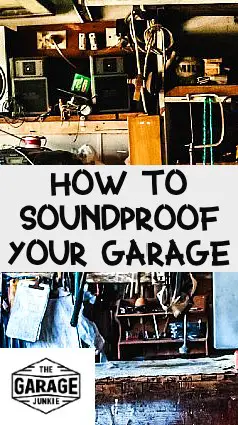There are several reasons that you may be looking into soundproofing your garage.

Maybe you are making your garage into a studio, or a movie room, or a man cave, or something else that might require less sound seeping through the metal garage door. Maybe with the new work-from-home movement, the only viable place to get away from the noise within the home is a make-shift home office in the garage.
If you are a woodworker like me and live in a suburban neighborhood, you need to be conscious of the noise levels when firing up the saws. We also live in a neighborhood where there are little kiddies’ bedtimes to work around. I like my neighbors and want to be considerate of their “after hours” schedules by not being overly disruptive. This has limited my worktimes to the early mornings, as the summer temps here in Arizona can get brutal.
Because of these limitations, I began to research how to soundproof my garage. I discovered that there are a number of great products out there that can help you accomplish this project goal. And when they work in tandem with each other, the outcome is pleasing to the ears. Here are some tips for how to soundproof your garage.
When soundproofing your garage, first determine if you are trying to keep outside sound from coming in, or if you are trying to reduce the inside noise (from tools and projects) going out. This could be either or maybe a combination of the two. Once this has been determined, there are some targeted areas where you can add soundproofing measures to keep noise from transferring. These areas include the garage door, the garage entry door, the walls, the ceiling, and the vents.
Before you start looking into the individual tips suggested in this article. We want you to keep this in mind when discussing how sound is dampened. When soundwaves travel through different mediums (being different materials) the wave loses energy and the audible sound heard is reduced.
The second thing to keep in mind is that when you are trying to lessen the sound in the garage, you are trying to dampen the sound. Reducing the soundwave energy in the room will make it so there are less reverberation and reflections within the garage, and it will also reduce the amount of sound making it past the garage perimeter.
If you are contending with sound entering the garage from elsewhere, you are going to want to focus more on sound blocking and eliminating sound to come in rather than reducing sound energy with dampening products alone.
How to Soundproof Your Garage #1 – Garage Door
Garage doors are generally known for functionality and security but can be overlooked as a large component in your soundproofing plan. A standard two-car garage door generally takes up an entire side of your garage as a whole, and often directly faces the street – a large part of where outside noise comes from. The thin metal door on its own may keep your tools and car safe when locked into place, but keeping out street noise out is another matter entirely.
There are four treatments you should perform on your garage door to help dampen the sound coming in and out:
- First, add a sound barrier. Sound barrier is a dense vinyl that reflects sound. Having this installed on the thin metal of the garage door will greatly reduce the sound coming in and out from the garage door opening.
- Second, install garage door insulation panels. Garage door insulation is normally made of a fiberglass or foam panel that is installed against the door. The panels act as an insulator for heat transference, but the material is also used as a sound dampening material.
- Third, check the seals of the garage door. If you are seeing air gaps, that also means that sound is either entering or exiting unimpeded. If you see gaps, consider replacing the seals to help bolster your garage’s soundproofing capabilities.
- Fourth, check the bottom door seal. In the middle of the day, close the garage and turn the lights off. Do you see light coming in under the door? This could mean that the seal at the bottom is damaged or missing and it’s time for a replacement. Additionally, adding a garage door threshold to help seal the area between the garage door and the garage floor can add another layer of soundproofing.
How to Soundproof Your Garage #2 – Garage Entry Door
Garage entry doors are another area that can be effectively sound treated to reduce sound-transference going in or coming out of your garage:
- First, examine the door frame. Look around the frame to ensure that it was installed well and is seated properly in the frame. A lop-sided hanging door can have gaps that can be easily closed by tightening the screws in your door hinges. If this doesn’t solve your problem, you may need to re-drill and move the hinges to correctly position the door in the frame.
- Second, check the door itself. If your garage entry door is up to fire code, it should have a solid wood core, which should have decent sound-blocking capabilities because of the required thickness. If this is not the case, replacing the door might be your next move. Fire safety and sound-proofing can be done in one go.
- Third, check your door handles and latches. Your garage entry door should close and latch properly. Other soundproofing measures will be in vain if the door itself won’t stay closed. Again, tighten some screws, or look into a new handle and latch if needed.
- Next, check the door seals. Do a visual scan to see if the seals of the door are in good condition. If they are cracked or have chucks missing, replace the seals. If they look fine, do the same test as with the garage door – close the doors and turn off the lights during the day. If light is seeping around the door, replace the door seals to get better contact between the door and the frame so sound isn’t bypassing the entry door unimpeded.
- Also, check the threshold. While you are checking the seals, see if light is coming from underneath the entry door. If so, you might need to replace the threshold to seal up the gaps around the door.
There is also a final option for a more permanent solution to soundproofing the doorframe, but it will require some demo and reframing. Spray foam can be used as a barrier between the door frame and the door cavity. However, to install, the internal side of the door molding will need to be removed and then replaced after the foam is added. If you are building a home from the ground up and are considering soundproofing measures, this is one to look into before the door is installed.
How to Soundproof Your Garage #3 – Garage Walls
From my experience with attached garages, generally, the exterior walls for a garage are not insulated. Interior walls that are shared with the living space of the house are insulated. For soundproofing purposes, those external walls will probably need to be addressed.
There are several things you can do when soundproofing your garage exterior walls:
First, (and most effective) insulate the exterior walls. Adding Insulation to the walls will not only keep heat and cool from transferring through the wall, but can absorb soundwaves. If your garage’s exterior walls are simply studs, then the possibilities for this upgrade are endless. We suggest insulating the walls depending on what you are trying to accomplish when soundproofing your garage and your budget.
Insulating materials to explore:
- Fiberglass – Fiberglass insulation will work in less critical cases and will generally be the most cost-effective.
- Mineral Wool – Mineral wool is an amazing sound absorber and is also a very highly rated insulation.
- Spray Foam – Spray foam insulation provides you the best chance of fully sealing around electrical and pipes, eliminating as many openings as possible for sound to transfer. If your garage is previously drywalled, we suggest getting a quote to have your walls spray foamed rather than tearing out and reinstalling drywall on those exterior walls of the garage.
Next, add drywall (if you don’t already have some). If you are taking steps to soundproof your garage, we also recommend that you install drywall over the insulation. The dense material will act as a sound barrier and will provide another medium that the soundwaves have to travel through to be heard. Drywall also gives your garage a more “finished” look and can help with adding storage solutions later.
How to Soundproof Your Garage #4 – Garage Ceiling
When soundproofing the ceiling of your garage, the premise is technically the same as when you are trying to soundproof the walls of the garage.
- Look into different types of insulation first. Insulation in your ceiling is normally much thicker than in your walls, so we suggest that you pick insulation that fits the other needs of your garage and budget.
- Next, add drywall. Drywall will give you a finished look for your garage, but it will also provide an initial barrier for sound to be dampened and will also provide different insulation options for your garage space.
How to Soundproof Your Garage #5 – Garage Vents
Depending on where you are located and the climate you find yourself in, your garage may have built-in vents that can also be sound treated. My Dad lives in Florida and he mentioned that some garages have large vents located in block walls on the side of the garage. These are intended to help air circulate but can be another area where sound can move freely.
The simple solution may be to close up the vent entirely if you have other means of circulating air. However, if you’d like to keep your vent intact there are other options.
Building a sound maze might be a viable option to lessen the amount of sound that is transferring through the walls.

This is a basic example of a sound maze I built with a frame holding staggered sound-absorbing panels, made from fiberglass or mineral wool, like the image above. The sound maze will allow for air to move freely, but since soundwaves are linear, sound will be absorbed in the sound-absorbing panels.
Final Thoughts
Before diving too deep into this potential project, you really do need to consider what you are trying to accomplish when you soundproof your garage. If it is to quiet the saws when you are working early in the morning, or just to block out noise from traffic, this will require less treatment than if you were turning your garage into a recording studio. Make sure the efforts you put forth match the need, and you will save yourself time and money, while still accomplishing your goal.
